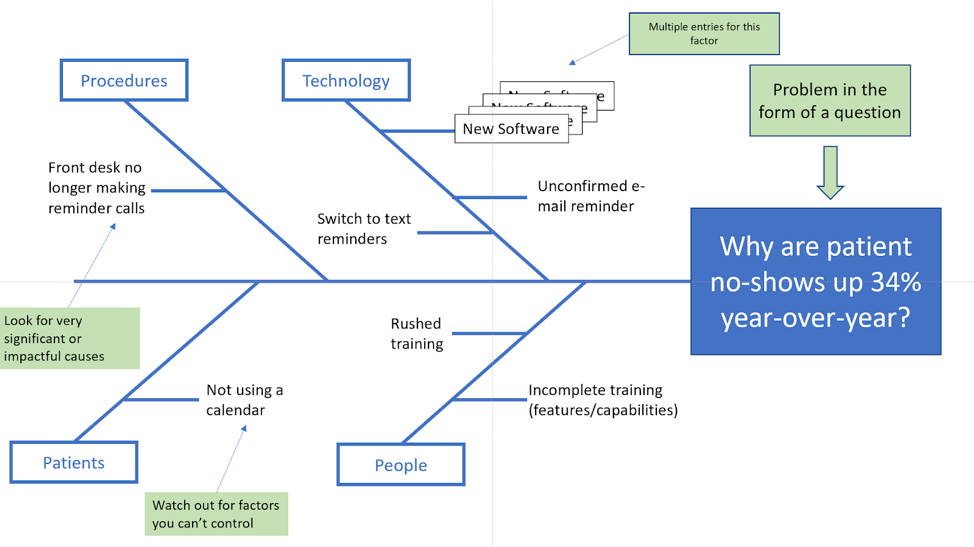
This article was written with contributions from Dave Spiciarich, MedAmorphosis process improvement expert.
The Fishbone Analysis tool can make your practice problem-solving wishes come true
There are those who learn by the auditory method, or being told what is needed, and those who are more visually oriented. The Fishbone, officially called the Ishikawa diagram, was popularized in the 1960s by Kaoru Ishikawa, and is considered one of the seven tools of quality management. The Fishbone Analysis (FBA) is now a standard tool for problem-solving in practice improvement projects.
The Fishbone Analysis begins with a problem and the fishbone structure diagram provides a template to identify and organize the causes. Usually, there are six categories, but the number can be changed depending on the problem. One version is to use the traditional six categories: machine, method, manpower, material, measurement and mother nature (environment). This method allows problems to be studied and provides everybody with an insight into the problem so solutions can be developed and then implemented.
When a practice uses FBA to evaluate a problem such as patient experience, clinical outcomes or compliance, there tends to be an open atmosphere that fosters greater understanding of the causes of a problem and quick identification of possible solutions.
Root cause analysis (RCA)
RCA is increasingly used in healthcare to improve safety, quality and minimize adverse events, as it provides a retrospective analysis of incidents or events.
The Fishbone Analysis diagram provides an effective tool to identify all the possible causes of a problem, not just the most obvious ones. The strength of the Fishbone diagram is twofold:
- The exercise drives creative thinking to uncover all the potential causes of the problem.
- Then it organizes those causes to help focus the attention of the team.
How to do a Fishbone Analysis for problem-solving
When using a Fishbone diagram method of root cause analysis, the following steps should be taken.
- First, identify the people who are familiar with the problem and can manage/approve potential solutions. Invite them to the team. Make sure the group is clear about the problem to be discussed and that everyone is in agreement. This is the most important step in the process. By properly defining the problem, the team will be able to focus its thinking to reveal the relevant causes. Pro tip: Phrasing the problem in the form of a question will help team members present their causes as answers to the question.
- Next, brainstorm all of the possible causes of the problem. This is not a time to be judgmental but a time to encourage everyone to participate. We like to have everyone write their ideas on a Post-it and stick them on a whiteboard for all to see.
- Once all the possible causes of the problem are listed, they can then be organized onto the fishbone. Start with the standard six sections, or determine if custom grouping is necessary (see the below example for custom grouping).
- Next, determine which causes are most impactful (impact and frequency).
- Perform root cause analysis (RCA) for the top issues identified and organize the root causes as “sub bones” on the diagram.
- Lastly, determine which root causes will get attention and solutions.
Developing solutions is the next step. This process elicits root causes rather than just symptoms and results in a detailed visual diagram of all the possible causes of a particular problem. Exploring issues in detail often reveals solutions that might not have been previously considered.
Although participating in an FBA exercise may seem time-consuming and daunting, the critical thinking skills gained through the experience can help doctors and staff enhance the patient experience throughout the practice.
The Fishbone at work

Oz Urology was experiencing a significant increase in no-show appointments. This was disruptive to the practice, causing lost income and decreased patient dissatisfaction.
Staff from the scheduling, reception and finance departments gathered together to try and figure out the cause behind the no-shows. Pam, the office manager, served as the meeting facilitator. She started by writing the problem to be addressed on a whiteboard: Why are no-shows occurring on average 4 times per week, an increase of 34 percent over last year? Working individually, she gave the team 15 minutes to write possible causes on sticky notes. Pam had listed four “bones” to group the problems into procedures, technology, patients and people.
While there were some good entries for each of the bones, it was clear from the start that the technology bone was getting most of the causes. The practice had implemented new scheduling software in the last five months that sent appointment reminders via text so the practice didn’t need to call or leave messages. The software also, allegedly, sent emails. In the people category, it had been noted that the training for the new system had been rushed and left incomplete. Standing alone on the procedure bone was the fact that front desk personnel were no longer making appointment reminder calls.
Looking at the Fishbone it was clear that the new software and the elimination of the appointment reminder call were the most impactful reasons for patients missing their appointments. Pam and the team agreed that the first action needed to be reinstating the reminder call until the software could be used more effectively.
Conclusion
The key to successful implementation of a Fishbone Analysis is to follow a rigorous process:
- Assemble the team.
- Identify the problem.
- Brainstorm possible causes of the problem.
- Organize the causes onto the “bones” of the fish.
- Determine which causes are most impactful.
- Perform a root cause analysis for the identified causes.
- Develop solutions for those causes.
Fishbone Analysis provides a template to identify and organize possible causes of a problem by allowing teams to focus on the problem, rather than complaints or survey results. It is useful in FBA to employ a team from across the practice to generate a sense of total participation rather than finger pointing. While the Ishikawa diagram has been used in manufacturing for decades, it is now being adopted in medical practices to improve quality, efficiency and the patient experience.
Need help solving problems in your practice?
Our MedAmorphosis practice improvement team assists practices in defining problems, determining possible solutions and implementing those solutions over time.